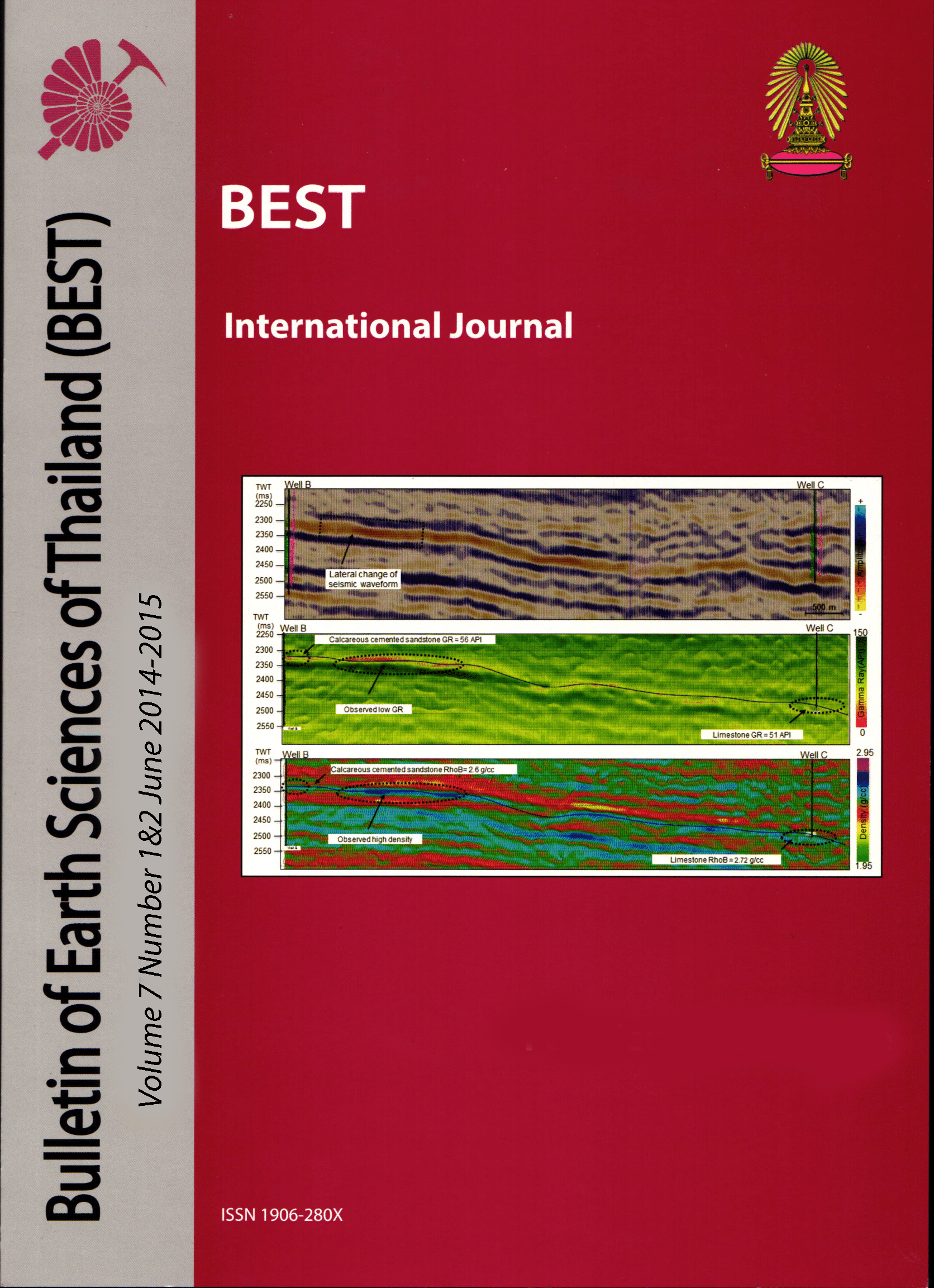IDENTIFICATION OF POTENTIAL SOURCE ROCKS USING SEISMIC ATTRIBUTES IN THE SYN-RIFT STRATIGRAPHIC SEQUENCE IN THE SOUTHERN PATTANI BASIN, GULF OF THAILAND
Main Article Content
Abstract
Estimation of source rock distribution is required to determine hydrocarbon charge in the reservoir. In the Gulf of Thailand, the southern Pattani Basin has limited wells that penetrate into the source rock and the size of the source rock volume is also unknown. Thus seismic facies mapping is the only way to map source rock distribution in the undrilled areas of the Basin. Mancharee_1 and Mayura_1 exploration wells drilled into Oligocene stratigraphy. Based on log analysis in the Oligocene interval, these two wells encountered organic-rich shale and a high radiogenic shale zone considered as the potential source rock due to their low AI (Acoustic Impedance) and high GR (Gamma Ray) values. This is the main characteristics of source rocks as they generally have decreasing AI due to increasing organic contents which reduces its density, velocity, and has a high GR. Based on AI difference, there will be contrasting reflections of source rock shale, sandstone, and shale in the study area. Matching well logs to seismic for seismic facies recognition of source rock showed that the top of source rock (top Oligocene) is represented as a trough. These potential source rocks give negative and positive reflection amplitudes. Consequently, the study of source rock distribution and mapping on seismic in areas of the Basin with no well penetrations including deeper parts of the Basin is very important for prediction of hydrocarbon generation. In deeper parts of the Basin, source rock formation would be expected to occur and have a possible high TOC content and maturity. This results in a decreasing AI in source rock compared to other rock types; hence the reflection amplitudes of source rock shales give strong negative and positive amplitudes. By using seismic data, the source rock delineation and thickness therefore can be mapped. The result of mapping source rock distribution is indispensable for petroleum system prediction.
Article Details

This work is licensed under a Creative Commons Attribution-NonCommercial-NoDerivatives 4.0 International License.
Copyright © 2008 Department of Geology, Faculty of Science, Chulalongkorn University. Parts of an article can be photocopied or reproduced without prior written permission from the author(s), but due acknowledgments should be stated or cited accordingly.
References
Lambiase, J.J., 1990, A model for tectonic control of lacustrine sequence in continental rift basin. Lacustrine Basin Exploration: Case Studies and modern analogs: AAPG Memoir 50, 265-274.
Lambiase, J.J., and W. Bosworth, 1995, Structural controls on sedimentation in continental rifts: Geological Society, London, Special Publications, v. 80, p. 117-144
Lockhart, B.E., Chinoroje, O., Enomoto, C.B., and Hollomon, G.A., 1997, Early Tertiary Deposition in the Southern Pattani Trough, Gulf of Thailand: Stratigraphy and Tectonic Evolution of Southeast Asia and the South Pacific, the Department of Mineral Resources, Thailand, p. 475-490.
Longley, I.M., R. Barraclough, M.A. Bridden, and S. Brown, 1990, Pematang lacustrine petroleum source rocks from the Malacca Strait PSC, Central Sumatra, Indonesia
LØseth, H., Wensaas, L., Gading, M., Duffaut, K., and Springer M., 2011, Can hydrocarbon source rocks be identified on seismic data?: Geological Society of America, v. 39, p. 1167-1170.
Passey, Q.R., S. Creaney, J.B. Kulla, F.J. Moretti, and J.D. Stroud, 1990, A practical model for organic richness from porosity and resistivity logs: AAPG Bulletin, v. 74, p. 1777-1794.
Schmoker, J.W., 1981, Determination of organic-matter content of Appalachian Devonian shales from gamma-ray logs: AAPG Bulletin, v. 65/7, p. 1285-1298.
Shayesmeth, M., 2011, Source rock analysis from well logs in the Southern Dezful Embayment: Presented at the 2nd Asian Geoscience Conference and Exhibition, GEOindia.
Sladen, C., 1997, Exploring the lake basins of east and southeast Asia: Geological Society, London, Special Publications, v.126, p. 49-76


